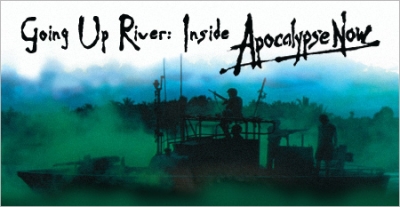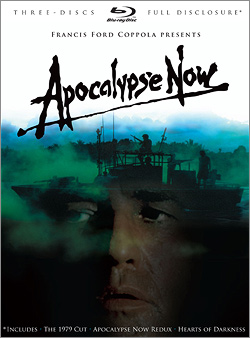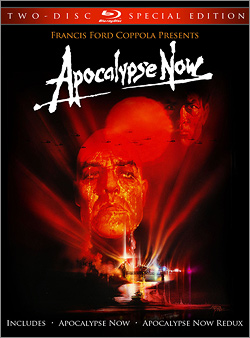To answer some of these questions, the production team at Lionsgate Home Entertainment and Coppola's American Zoetrope were kind enough to talk with The Digital Bits for nearly an hour last week. Participating were Lionsgate's Senior VP of DVD and Blu-ray Production, Miguel Casillas, and Zoetrope film archivist James Mockoski (who supervised the new restoration of the film), along with colorist Doug Delaney and Jay Miracle, the editor of the Hearts of Darkness documentary (he also worked on the original Apocalypse Now). What follows is a transcript of that conversation. We hope you'll enjoy it!
---
Bill Hunt (The Digital Bits): We might as well start off right away by talking about the issue that – I don't know if controversial is the right word, but it's certainly the most talked about issue related to the home video releases of Apocalypse Now, which is the aspect ratio. All of the previous DVD versions have presented the film in the 2.00:1 aspect ratio preferred by cinematographer Vittorio Storaro. On the other hand, the film was originally shot and presented theatrically in the 2.35:1 ratio. So how was the decision made to go 2.35 at long last for this Blu-ray release?
James Mockoski (American Zoetrope): This is a decision that Francis and Vittorio made together back in 2001 – to offer the 2.00:1. Francis very much supported – and still supports – Vittorio's vision of 2:1. It's not just a widescreen issue. It's well publicized on Vittorio's website how he thinks film should be presented. It goes back to Leonardo da Vinci, and he has a whole philosophy about looking at artwork in 2:1. Honestly, if we could, we would have included a 2:1 version on the Blu-ray along with the 2.35:1. Of course, people have wanted the 2.35:1, so we wanted to include that, but we don't discount what Vittorio did either. And we had a long discussion with Lionsgate about how we could do both. But Francis has certain specifications about this release that he wanted. One of the criticisms of the last release was that the film was broken up over two discs. So this time, we wanted to offer both Redux and the original cut on one disc. That meant [for disc space reasons] we had to choose: 2.35 or 2:1. We just couldn't have both, which Francis wanted. So we chose 2.35 because it was the original aspect ratio of the film.
Bill Hunt: It's fascinating to me that there's a completely valid artistic argument to be made for both aspect ratios. It wasn't just some arbitrary decision to go 2:1 originally.
James Mockoski: I know. Miguel and I talked for hours about this. Vittorio would still argue that 2:1 is a valid thing to do for widescreen presentation. He has a whole philosophy about how people view films, and he feels that 2:1 gives them the best presentation of a film.
Miguel Casillas (Lionsgate): And James, I think we had also spoken at one point about the whole advent of a 16x9, widescreen monitor world, which might not have been as prevalent back in 2001 but certainly is now. If you believe in the philosophy that Blu-ray offers the best verbatim reproduction of a theatrical experience, then that's one advantage of doing the 2.35 on the Blu-ray, along with the fact that it hadn't been done before. And if you could hearken back to how audiences would have seen Apocalypse Now back in 1979, it would have been in this visual presentation.
Bill Hunt: Certainly, judging by the feedback of the film's fans, 2:35 is definitely what they've wanted to see for a long time. On the subject of the visual presentation, can you guys talk about the new transfers of the films? Specifically, the restoration work that was involved in creating the Blu-ray master, and what might be different or improved from 2001 to now?
James Mockoski: Sure, I can walk you through the steps of how we got it to mastering, and Doug can talk about the color. We chose the inter-positive of Apocalypse Now Redux and had it transferred at 4K. That gave us the best quality to start with, because the original negative had suffered damage over the years. And Doug and iO Films had it down converted to 2K so they could work in color.
Bill Hunt: Now, I know that the original elements for the theatrical cut were essentially taken apart and repurposed for Redux, so how was that version handled?
James Mockoski: Basically, for Redux, about 45 minutes of footage was added, in addition to the theatrical cut. There's a slight difference in edits, but basically it was just an insertion of additional footage in 2001. So the theatrical cut of Apocalypse Now is there in the I.P. of Redux. So we took the I.P. transfer and, using seamless branching on Blu-ray, it just skips over the added footage to present the 1979 cut.
Bill Hunt: So both versions are sourced from the same 4K transfer.
James Mockoski: Yes.
Comparison of the 2001 I.P. (top) and 2010 Blu-ray master (bottom).
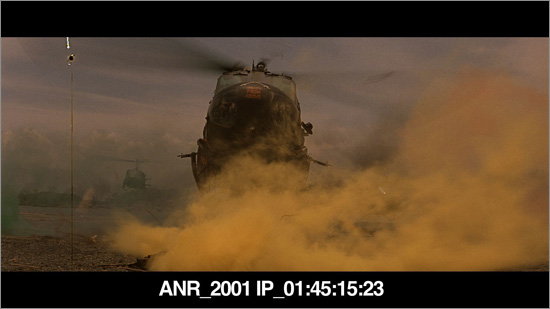

Bill Hunt: Looking at the screenshot comparisons you guys provided between the 2001 master and the new 2010 master, there's a marked difference in the color-timing. Color seems more vibrant now, and contrasts are bolder. Can you talk about that? How those decisions were made and what the differences might be?
Doug Delaney: Sure, I can touch on that and James can chime in. One of the original conversations we began to have when we started looking at doing this work, was using the original transfer in 2001 as a reference – as indicative of the best possible transfer at the time, using that technology, and with a lot of time spent with Vittorio on that original transfer. We also screened – myself, James and Mr. Coppola – the dye-transfer print as well. And we wanted to get back to that in terms of not just aspect ratio, but the contrast and color saturation characteristics of a dye-transfer print in terms of its natural rendition – to be a little bit more, I guess, faithful to that original projection of that dye-transfer print. To get to that point, there was a little bit of negotiation between using both sources as inspiration, I guess is the best way I could put it, between that beautiful dye-transfer print Mr. Coppola had as well as honoring the time and quality of the transfer in '01 that obviously had Vittorio's time put into it. Some scenes tended to carry over very well with regard to the two transfers, and some scenes felt more akin to the dye-transfer print.
Bill Hunt: So in other words, the goal was to get as close to that original dye-transfer presentation as possible, but still have it informed by Francis and Vittorio's 2001 work and the improvements over time.
Doug Delaney: Yes, I say that's it.
James Mockoski: You know, Vittorio has always been a lover of Technicolor. And what Redux allowed us to do in 2001 was, Technicolor brought back the machine and installed it – that replicated that Technicolor process. I think Bulworth was the first film off that machine, and Redux was the second. But it allowed Vittorio to have that great saturation of colors and deep, deep blacks that Francis and Vittorio just love. You do lose a little bit of that in the [2001] D5 transfer, but now we at least can get closer to that original Technicolor look that they wanted to have.
Doug Delaney: So certainly, you'll see some of these scenes that have this very rich black – the sort of inky quality that you get from a dye-transfer print that is difficult to reproduce otherwise. And it creates a very sort of bold contrast image, yet has a more natural, filmic feel.
Bill Hunt: Given the way film stocks can age and fade over time, is there any thought given to the notion that this new master – this presentation has an archival purpose? That it becomes a lasting reference document to what the film should look like?
James Mockoski: Well, that's another conversation we've had. We had hoped that the [2001] D5 was that end all, because of the work put into it and the input everyone had. But who knows in 20 years? Fortunately, the Technicolor print is a more preservation medium in terms of keeping a good record of color, with the separation. So yes, we would like to think today that this is the definitive record. But we'd probably get burned if we said this is it. (laughs) Technology will come along in another 20 years and suddenly you've got to do a 12K scan next.
Bill Hunt: It's always been amazing to me how much – even over the space of a year or two – the state of the art in mastering can evolve and improve.
James Mockoski: (laughs) And yet Francis and Vittorio are doing interviews saying, "This is it."
Bill Hunt: I guess the important thing to note is that Francis and Vittorio were involved and made the decisions regarding this new presentation – Vittorio, I suppose you could say, in the form of the 2001 presentation, which contains his visual notes on color.
James Mockoski: Yes. Francis primarily was responsible for this restoration, with Vittorio's blessing of the print that he deposited in 2001.
Bill Hunt: While we're talking about the restoration, let's touch on the clean-up work that was done to the Redux and 1979 version...
James Mockoski: If you did a side-by-side, and you looked at the D5 back in 2001 – and Doug can speak on this too – it looked beautiful then. But during this new HD version, there's a lot of stuff you see that you didn't see in the D5, when you do a side-by-side comparison with the 4K. There was a lot of dirt and scratches. So we spent a lot of time cleaning up the film. So yes, we were very happy back in 2001, but now with the Blu-ray, it looks even better. But Francis... as we were sitting in the room with Doug... we'd be calling attention to a hair in the gate, and Francis would say, "You know... this film is made by humans. Yes, there was a hair in the gate back in '79. I'm not going to be worried about that." Because it just reminds us of the effort it took to get this film to the screen. We could spend countless hours cleaning, but we didn't want to strip away that hands-on aspect of it. So occasionally, if there was a hair in the gate and it was minor, we left it.
Bill Hunt: I think that will be comforting to the serious fans of the film, because one of the issues that's come up with Blu-ray is: Just how 'perfect' should older films look in high-definition? Apocalypse Now isn't supposed to look like Avatar. It shouldn't look like that – it was never meant to.
Doug Delaney: Yeah, that was one of the earlier discussions we had in terms of color correction and digital restoration – the issue of the 'modernization' of a film like this. We wanted to allow it to be a film. Certainly, our technical standards have changed over the years, and the viewers' standards have changed in terms of the education and home theatre quality. But all that being said, how far did we want to go with the restoration? We didn't want to cross that line of modernizing a seminal piece of American cinema. We wanted to retain that dye-transfer, filmic contrast and the deep blacks – we didn't want to leverage all of the digital technology to make it something as if it was shot on an HD camera today. We could have spent hours and hours and hours taking out ever single piece of dirt, but that wasn't the goal. We worked hard to find the right balance.
Comparison of the 2001 I.P. (top) and 2010 Blu-ray master (bottom).
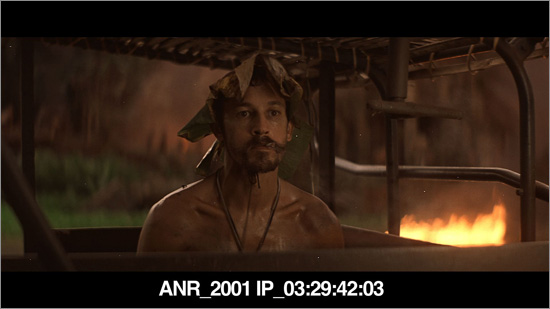
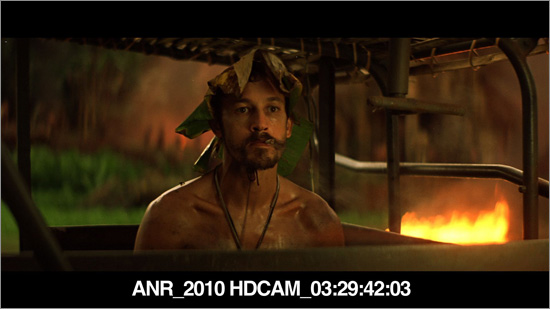
James Mockoski: For us, you know, some of those things – that's the feeling of a film.
Doug Delaney: Some of the difference too [in what you'll see on the Blu-ray] is just the improvement in transfer technology itself from 2001 to 2010. The source now – coming from a 4K scan – has so much more detail. There wasn't a lot of enhancement needed. That one of the other things you can see from the [comparison] stills – the clarity and sharpness and texture that remains through that process but is not overly enhanced.
Bill Hunt: Now, moving on to the other content of this release, one of the most exciting aspects of it is that the Hearts of Darkness documentary is being included with the film for the first time. And I understand that it's also in high-definition. How did that come to happen?
James Mockoski: Jay Miracle helped us on that. He did the color timing of that over at iO Films as well. It was also transferred from the I.P. in HD and they worked from there.
Bill Hunt: The documentary was originally shot in 16mm, was it not?
James Mockoski: Yes and no. All of Eleanor's footage was shot 16mm, but they blew that up to 35. Jay, you know more about that process...
Jay Miracle: Yeah, all of that was 16. What was amazing to me is that you all did an incredible job. Even that original footage – it just looks pristine. It was incredible. I was really blown away at how good everything looks - at the quality of the transfer.
James Mockoski: Basically, that material was left in the vault for 20 years. So it was in very good shape. The only thing – we had a laserdisc and a VHS made back in the 90s. So very little had been done on the title. And what you saw on the 2007 DVD release was a Digibeta that was made off a 1-inch source.
Bill Hunt: So it would be fair to say that few people have ever seen the documentary looking as good as it will on the Blu-ray?
James Mockoski: Yes. And the 3 or 4 prints that are out there in circulation are really faded. So people will have not seen Hearts of Darkness looking as good as this.
Comparison of Hearts of Darkness - previous DVD master (top) and 2010 Blu-ray master (bottom).
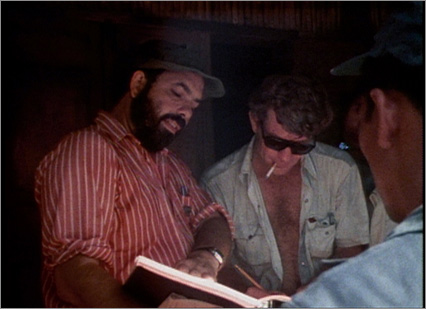
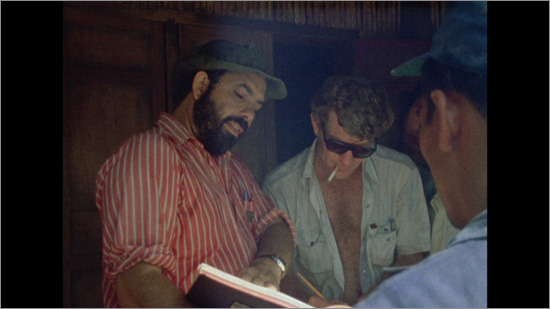
Bill Hunt: Let's talk about the other extras that will be on the Blu-ray. And Miguel, you can probably address some of that. Looking at the spec list, it looks very much like everything of consequence from the previous Complete Dossier DVD release is carrying over to the new Blu-ray. Is that correct?
Miguel Casillas: Absolutely. And we worked very closely with James and Zoetrope to produce the features. This is really kind of their 'container' if you will. We're just trying to help bring Francis' vision to light. But that was basically the idea – that for the ultimate fan, this is probably as close as you can get to owning a piece of the film, with all of the mythology and lore, in one box set. We're really proud of that. We think it's a really cool effort, and we couldn't have done it without Zoetrope. Hopefully, when you see it you'll agree. The great thing about it is that the way it's put together and indexed is a very elegant menu system. It's a very nice approach – it's easy for the fans to get through and find the bits they want. And hopefully this is a box set that you can't go through in the first night. There's just a lot of content that's on there.
Bill Hunt: Well, two versions of the film, Coppola's commentary, the documentary, all the previous Dossier features... plus new content?
Miguel Casillas: Yes!
Bill Hunt: That's definitely a lot of material. Let's talk about that new content. What's specifically new here? What's going to surprise fans that they may not have known about before?
James Mockoski: We have Francis interviewing Martin Sheen. And also we have Francis interviewing John Milius. Francis has always gotten credit for writing the film, but he wanted to give John more credit because actually the inspiration came from John and George Lucas. So he wanted to be more public about that. He wanted John, in his own words, to speak on the inspiration and how he came to develop Apocalypse Now.
Bill Hunt: Looking at the list, there's also the Coppola interview by Roger Ebert from Cannes in 2001?
James Mockoski: Yeah, there was a little bit of it on one of the extras from '06, but this is the complete interview.
Bill Hunt: And there's a new casting featurette...
James Mockoski: Which has Fred Roos talking about his experiences with Francis to cast the film back in 1976, so we have a lot of rehearsal footage from a month before they go on to film.
Bill Hunt: Wow. And I understand there's a Mercury Theatre radio drama with Orson Welles as well?
James Mockoski: Yes. Lionsgate dug up a recording of that from 1938...
Miguel Casillas: It features Welles. It's a reading of Joseph Conrad's Hearts of Darkness, which was part of the inspiration for Apocalypse Now. It's very archival, but I think for any über-fan it's a cool experience.
Bill Hunt: I understand also that there are storyboard, photograph and marketing archives. Galleries, I assume – can you talk about them?
Miguel Casillas: Basically we worked with James and his team to dig up just a lot of the old cool posters and lobby cards, images of the script with Francis' own notes – an excerpt from the shooting script. Just basically all of the experience stuff that fans love. We even transferred the original trailers in HD. What can I tell you? I love trailers. And I don't think anyone has seen some of that before.
Bill Hunt: I just love the idea that the trailers are HD. Those are usually an afterthought on most releases – especially on Blu-rays.
Miguel Casillas: Yes. What we tried to include is really the history of the film as it related to American and world cinema. You just can't leave out the whole marketing and promotion of the film, because there was a very certain elegance and beautiful style to it – to some of the posters and materials, and just how things were done back then, before the MTV and Internet generations came along. It was important to us to kind of capture that and offer that for fans to experience and understand. And another great thing that I'm happy about on the disc is, with one of our partners, MetaBeam, there's an application that you'll be able to download for free from the Apple store, so that if you have an Apple product – an iPad or iPhone - you'll be able to actually experience that marketing gallery in more detail on your device.
Bill Hunt: That's actually a very clever use of that kind of advanced connectivity – to be able to view such still images in greater detail.
Miguel Casillas: Right. Because as beautiful as these things will look on the Blu-ray, a TV screen just isn't meant to really display images like that. It's such a 5-foot experience. We wanted to offer people a chance to really look at these things and really appreciate them in a more handheld way – a more intimate experience if you will.
Bill Hunt: Speaking of that, the film was originally presented – the 70mm screenings at least – in a "roadshow" format, without credits. And those were included in a pressbook at the screenings...
James Mockoski: Yes. Jay may actually remember how that was done. As I understand it, they gave out the program at the 70mm screenings, but when they went to 35mm general release, it wasn't economically feasible to give out the programs, so they added the credits.
Jay Miracle: That's true. They had a pamphlet. I actually still have a few copies. I thought it was quite brilliant. It was quite an experience – I went to a lot of the original screenings, having worked on the movie. It's why I'm very excited to see this new version. Hearing you guys talking about all this, I'm just sitting here thinking, "Wow!" (laughs)
James Mockoski: Jay you were originally part of Eleanor's crew?
Jay Miracle: I was actually a sound editor. And I was sort of based at Zoetrope for about 4 or 5 years. I was a kid – I was going to Berkeley at the time. And I was very involved at Zoetrope. It was really a great experience for me. So this is very exciting! There's just so much incredible material that's available out there for this film, that I don't think anyone has seen, at least not for a long time. And it really was an amazing marketing coup at the time. I remember when they had the first screening at the Cinerama Dome, and a lot of the preview screenings. There was a lot of excitement. But there's just so many aspects to this story – the story of the film – and it'll be great to see it.
Bill Hunt: It's always interesting, especially on a film of this scale, just how much material gets collected and created – how much goes into the production – that most fans never get to see.
Jay Miracle: Right, a tremendous amount of work, a tremendous amount of documentation. We looked at a lot of Vietnam War materials, things of that nature.
James Mockoski: It's funny that you bring that up, because I just came across some of those old 16mm prints from the Navy – archival footage of PBR boats going up the river.
Jay Miracle: Yeah, a lot of that provided inspiration. Even the bit with the soldier with the puppy – all those kinds of things.
Bill Hunt: I know that the new Blu-ray also has a 48-page book included in the package – I would assume that some of that archival print and photo-based material will be included there?
James Mockoski: The original pressbook material is in the marketing gallery on the disc. But Francis came up with his own book of how he wanted some of the documents related to the filming experience to be presented, with his own notes – a lot of the letters from the set, release memos to the crew in the Philippines. So you get a good raw look at what it took to live in the Philippines during the filming. This was what – 2... 2 1/2 years? Families had to move there. And it must have been hard for them. A lot of this experience gets overlooked. But there was a whole personal aspect to making this film for the people who actually had to live there. So we tried to give a little bit of that kind of flavor in the book.
Bill Hunt: In terms of specific extras that our readers have asked about on the Blu-ray, is the "Destruction of the Kurtz Compound" footage included with Coppola's commentary?
James Mockoski: Yes, it's on the new release and it's transferred in HD. And there's the additional deleted footage in SD.
Comparison of the 2001 I.P. (top) and 2010 Blu-ray master (bottom).
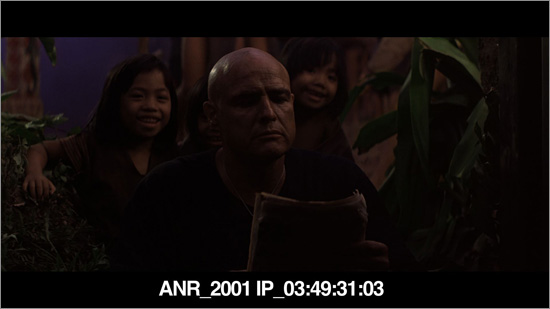
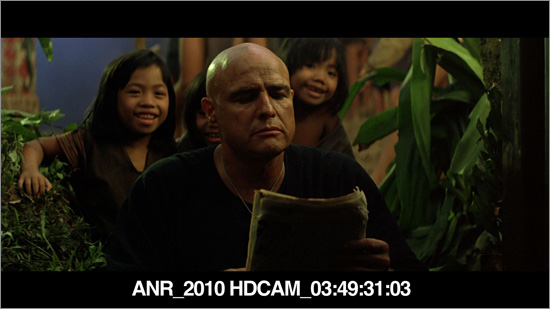
Bill Hunt: And the preexisting documentary commentary from the Hearts of Darkness DVD, with Eleanor and Francis – that carries over as well?
James Mockoski: Yes. Everything that was on the DVDs from '06, that's on the Blu-ray as well.
Bill Hunt: My one last question is, now that Lionsgate has partnered with Zoetrope to release the Zoetrope catalog of films on DVD and Blu-ray, what might be next in terms of titles to expect?
Miguel Casillas: I think if you look at the trailer gallery on the Blu-ray, Bill, you might see a clue of what's coming up next...
Bill Hunt: Ah! Perfect – something else for Coppola fans to look forward to! Well, I'd say that's a good place to wrap up. Thanks to all of you for your time, guys. I know I certainly can't wait to get my hands on the Blu-ray, and I think a lot of other people will feel the same way when they read this.
Miguel Casillas: I would just close by saying that I think fans are going to be really, really pleased with this release. I know we're all very proud of it. Zoetrope did an amazing job in producing and securing all of the elements, in the mastering. Just going back to the real star of the box set, which are the films themselves – they look fantastic.
---END---
Special thanks to Miguel, James, Doug and Jay for their time and hard work, along with Lionsgate's Jennifer Sandler and Dustin Dean for all their efforts on this release as well, and also for their assistance with this interview. The Apocalypse Now: Three-Disc Full Disclosure Edition Blu-ray – and Two-Disc Special Edition Blu-ray – will arrive in stores on October 19th, and can be pre-ordered on Amazon.com now by clicking on the provided links. Read my full review of the Blu-ray here at The Digital Bits. And be sure to visit Lionsgate's official website for the release, which includes a trailer and more. Hope you enjoyed the interview!
- Bill Hunt
